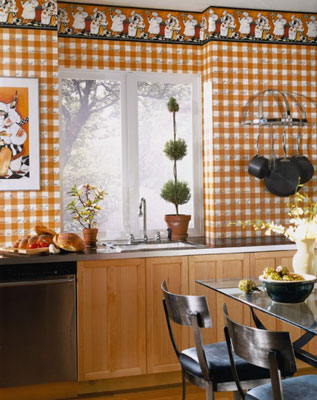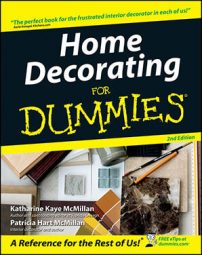Patterns on walls, floors, and ceilings can create a highly distinctive background for a room. Use them to compensate for inadequate architecture (a vertical stripe raises the too-low ceiling, for example), to make up for the lack of a view (choose a mural), or to add texture to lackluster sheetrock walls (pattern implies texture). The following are general guidelines for using pattern as a background:

Choose a pattern and its color based on the room’s size: An overwhelmingly large pattern in a neon-bright, warm color makes a small room look smaller, while an underwhelming, too-tiny pattern in a bland color makes a large room seem ho-hum. To pick the most helpful pattern (and color) for your room, keep the room’s size in mind.
Small rooms: Select softly colored patterns with light backgrounds. Patterns with three-dimensional effects, such as a trellis pattern, ribbon-and-floral stripes, or toile de Jouy (a scenic pattern), make the room seem larger.
Medium rooms: Pick stronger colored patterns in mid-sized rooms, but stick to light backgrounds to make the room seem larger rather than smaller.
Large rooms: In larger rooms, you can be bold. Choose strong, dramatic patterns with rich, exciting background colors.
Choose a pattern based on the house’s overall style for compatibility: Don’t create a split personality for your house by choosing Traditional patterns for a Contemporary house. Do keep in mind your home’s basic architectural orientation and your region of the country.
Contemporary rooms: Stick to geometric patterns in neutral or no colors. Stripes are good. Avoid Traditional (realistic) floral patterns; go for abstract ones instead.
Traditional rooms: For real compatibility, look to Traditional patterns those based on historic examples called documents. They’re easy to find and usually created in current colors. And if you really need authentic reproductions of wallpapers and fabrics from a certain period, you can probably find them. Wall-covering retailers, manufacturers, and interior designers are good sources of information. For shock value or Contemporary eclecticism, choose a Contemporary geometric.
Scale the pattern size to the room size: Use small patterns in small rooms, medium-sized patterns in medium rooms, and large-scale patterns in large rooms. This rule is a general guideline. However, if you want to use a gigantic floral (perhaps a sunflower) in a small room, (say a laundry or a powder room), go ahead. Whimsy is great fun!

